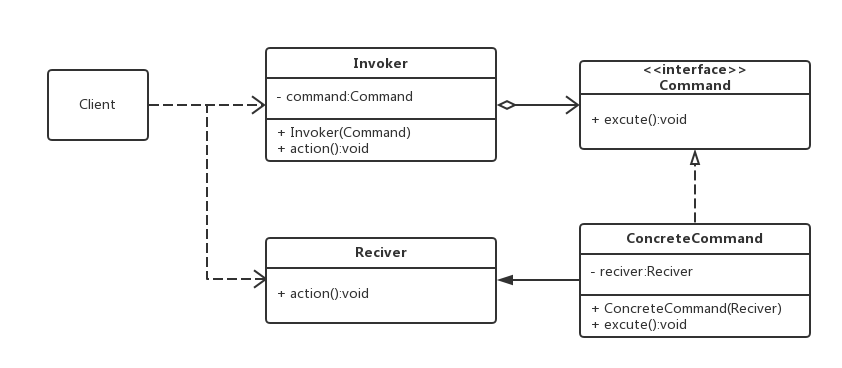设计模式之---命令模式
来源:互联网 发布:淘宝服装模特摄影 编辑:程序博客网 时间:2024/06/08 09:14
命令模式是行为型设计模式之一。命令模式没那么多条条框框,所以很灵活。命令模式简单的说就是给他下一个命令,然后他就会执行和这个命令的一系列操作。例如点击电脑的关机命令,系统会执行暂停,保存,关闭等一系列的命令,最后完成关机。
命令模式也跟关机一样,将一系列方法封装为一个方法,用户只要执行这个方法就会执行封装的一系列方法。不过真正用起来并不是这么直白简单。
定义
将一个请求封装成一个对象,从而让用户使用不同的请求把客户端参数化;对请求队列或者记录请求日志,以及支持可撤销的操作。
使用场景
- 需要对行为进行记录,撤销,重做,事务处理时。
- 需要抽象出待执行的动作,然后以参数的形式提供出来。
UML

- Receiver : 命令接收者,负责具体执行一个请求。在接收者中封装的具体操作逻辑的方法叫行动方法。
- Command:命令角色,定义具体命令类的接口。
- ConcreteCommand : 具体的命令角色。,实现了Command接口,在excute()方法中调用接收者Receiver的相关方法,弱化了命令接收者和具体行为之间的耦合。
- Invoker:请求者角色,调用命令对象执行具体的请求。
模板代码:
接收者,执行具体命令
- 1
- 2
- 3
- 4
- 5
- 1
- 2
- 3
- 4
- 5
抽象的命令
- 1
- 2
- 3
- 1
- 2
- 3
具体的命令
- 1
- 2
- 3
- 4
- 5
- 6
- 7
- 8
- 9
- 10
- 11
- 12
- 1
- 2
- 3
- 4
- 5
- 6
- 7
- 8
- 9
- 10
- 11
- 12
发起请求者
- 1
- 2
- 3
- 4
- 5
- 6
- 7
- 8
- 9
- 10
- 1
- 2
- 3
- 4
- 5
- 6
- 7
- 8
- 9
- 10
客户端调用
- 1
- 2
- 3
- 4
- 5
- 6
- 7
- 8
- 1
- 2
- 3
- 4
- 5
- 6
- 7
- 8
输出

简单实现
接下来就以俄罗斯方块举个例子。将俄罗斯方块这个游戏看做是命令接收者,我们的手柄按键作为命令请求者。
先创建一个游戏,执行具体命令
- 1
- 2
- 3
- 4
- 5
- 6
- 7
- 8
- 9
- 10
- 11
- 12
- 1
- 2
- 3
- 4
- 5
- 6
- 7
- 8
- 9
- 10
- 11
- 12
创建抽象命令接口
- 1
- 2
- 3
- 1
- 2
- 3
创建三个具体命令
- 1
- 2
- 3
- 4
- 5
- 6
- 7
- 8
- 9
- 10
- 11
- 12
- 1
- 2
- 3
- 4
- 5
- 6
- 7
- 8
- 9
- 10
- 11
- 12
- 1
- 2
- 3
- 4
- 5
- 6
- 7
- 8
- 9
- 10
- 11
- 12
- 1
- 2
- 3
- 4
- 5
- 6
- 7
- 8
- 9
- 10
- 11
- 12
- 1
- 2
- 3
- 4
- 5
- 6
- 7
- 8
- 9
- 10
- 11
- 12
- 1
- 2
- 3
- 4
- 5
- 6
- 7
- 8
- 9
- 10
- 11
- 12
创建一个按钮,这个按钮发起命令
- 1
- 2
- 3
- 4
- 5
- 6
- 7
- 8
- 9
- 10
- 11
- 12
- 13
- 14
- 15
- 16
- 17
- 18
- 19
- 20
- 21
- 22
- 23
- 24
- 25
- 26
- 27
- 28
- 29
- 1
- 2
- 3
- 4
- 5
- 6
- 7
- 8
- 9
- 10
- 11
- 12
- 13
- 14
- 15
- 16
- 17
- 18
- 19
- 20
- 21
- 22
- 23
- 24
- 25
- 26
- 27
- 28
- 29
客户端调用
- 1
- 2
- 3
- 4
- 5
- 6
- 7
- 8
- 9
- 10
- 11
- 12
- 13
- 14
- 15
- 16
- 17
- 1
- 2
- 3
- 4
- 5
- 6
- 7
- 8
- 9
- 10
- 11
- 12
- 13
- 14
- 15
- 16
- 17
最后输出

说明
可能看到上面写那么一大堆东西,最后就实现那么点功能,是不是觉得太麻烦了?确实太麻烦了,上面的功能其实几行代码就搞定了:
- 1
- 2
- 3
- 4
- 5
- 6
- 7
- 8
- 1
- 2
- 3
- 4
- 5
- 6
- 7
- 8
输出同样是:

这其实也体现出来了命令模式的优点和缺点,命令模式提供了更低的耦合度,更好的扩展性,但也生成了大量的命令类。膨胀极其迅速。
总结
命令模式本质就是将命令进行封装,将命令的发起者和真正的执行者隔离,降低耦合度。
命令请求者只需要发起请求,命令的具体执行时什么用,由谁执行都不需要知道。
优点
- 降低了请求者和发起者的耦合,降低了系统的耦合度
- 对命令更容易控制,可以自由组合不同的命令组。
- 对命令的拓展极其容易,新命令很容易加到系统中
缺点
- 类的数量膨胀太严重。
阅读全文
0 0
- 设计模式之命令模式
- 设计模式之命令模式
- 设计模式之命令模式
- 设计模式之命令模式
- 设计模式之命令模式
- 设计模式之--命令模式
- 设计模式之命令模式
- 设计模式之命令模式
- 设计模式之命令模式
- 设计模式之命令模式
- 设计模式之命令模式
- 设计模式之命令模式
- 设计模式之命令模式
- 设计模式之--命令模式
- 设计模式之命令模式
- 设计模式之命令模式
- 设计模式之命令模式
- 设计模式之 命令模式
- shell解析命令行的过程以及eval命令
- 初识scala
- Qt+ffmpeg仿格式工厂:编程中遇到的问题(三)
- 51nod1265判断四点共面
- 【github myLocker】select监听多个fd,互斥锁保护终端交互
- 设计模式之---命令模式
- CSS中关于触发BFC
- EasyDSS高性能流媒体服务器前端重构(二) webpack + vue + AdminLTE 多页面提取共用文件, 优化编译时间
- 理解高并发(20).大白话阿姆达尔定律
- 机器学习第九课(bagging,随机森林,样本不均衡)
- 各大公司对于java求职者的要求,你值得一看
- Thinkphp 模型->区间查询
- Test...
- 抽象类和接口


